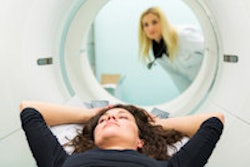
The use of PET/CT can improve radiation treatment planning for patients with head and neck cancers (HNCs), according to a review of studies that was recently published in the World Journal of Radiology.
The researchers, led by Musaddiq Awan, MD, from Case Western Reserve University, sought to investigate the particular benefits of PET/CT for radiation treatment planning in patients with squamous cell carcinomas of the head and neck.
Radiation therapy plays a central role in the treatment of HNC patients, and limiting toxicity is particularly important for the growing number HPV-related oropharyngeal cancer patients. These patients are generally younger with few comorbidities and, thus, are expected to live longer with long-term radiation complications.
Integrating tumor biology from PET/CT images with advanced delivery techniques using intensity-modulated radiation therapy (IMRT) and image-guided radiation therapy can significantly affect outcomes in head and neck cancer (World J Radiol, November 28, 2015).
FDG-PET can help clarify the extent of the primary tumor and eliminate unnecessary treatment for findings that may appear as abnormal on CT or MRI, the researchers noted.
Artifacts from amalgam-based fillings and other dental procedures can significantly distort and hinder CT-based target delineation for primary tumors in patients with head and neck cancer. However, the resolution of FDG-PET is not significantly modified by dental artifacts, making it practical for target delineation in this context.
For patients with high-risk features or those who have prolonged intervals between surgery and radiation, a postsurgery and preradiation FDG-PET scan will be valuable for treatment decisions and radiation treatment planning, according to the authors.
"Both preoperative and postradiation PET/CT may also assist in predicting the likelihood of disease-free survival and locoregional recurrence after postoperative radiation," the authors wrote.
PET vs. CT, MRI
Most studies investigating the effects of additional PET imaging on primary and lymph nodal volumes for radiation treatment planning have found major discrepancies between CT-based and PET-based volumes, resulting in clinically significant implications for radiation therapy, according to the authors.
In a study of 38 HNC patients, tumor sizes displayed by CT imaging were larger than those shown by PET in 92% of cases (International Journal of Radiation Oncology, Biology, Physics, March 1, 2009, Vol. 1:73, pp. 759-763).
FDG-PET is especially helpful when it is difficult to separate the tumor from surrounding soft tissue and muscle with CT, such as a tumor in the tongue or oropharynx, the researchers noted. It can also help identify the extent of tumors that are not detectable on either CT or MR images, particularly since HNC patients often have synchronous second primary tumors.
"FDG-PET can help detect additional primary disease to be included in the high-dose radiation field," they wrote.
In addition to delineating primary tumors, FDG-PET can help clarify the involvement of metastatic lymph nodes in HNC patients. Small malignant lymph nodes in particular may be missed using CT or MRI criteria alone, the authors noted. In a 1998 study, PET's sensitivity and specificity for predicting involved nodes was estimated at more than 90% (European Journal of Nuclear Medicine and Molecular Imaging, September 1998, Vol. 25:9, pp. 1255-1260).
“Because of the high sensitivity of FDG-PET to detect metastatic lymph nodes, it should be the best modality in selecting patients for this treatment.”
In a comparison of CT-based and PET/CT-based treatment planning, PET/CT directly improved parotid and laryngeal doses, sparing patients from long-term toxicities of xerostomia and dysphagia, the authors wrote.
"Because of the high sensitivity of FDG-PET to detect metastatic lymph nodes, it should be the best modality in selecting patients for this treatment," they wrote.
For patients who have preoperative FDG-PET scans, registration of the PET images to postoperative simulation CT images can help define the tumor beds.
"Through image registration, the radiation oncologist is able to directly correlate the pretreatment disease volumes to the postoperative CT imaging and delineate high-risk areas to be included in the high radiation dose field," the group wrote.
Future possibilities
In addition to the commonly used FDG, many newer radioisotopes and radiotracers are being developed to image functional characteristics of tumors including hypoxia, amino acid metabolism, and the presence of epidermal growth factor receptors (EGFRs) on tumor cells, according to the authors.
Another interesting possibility is the use of the tracer fluorothymidine (FLT) to image tumor cell proliferation and deliver higher doses to areas of the tumor showing a greater degree of growth.
There has also been an evolution in imaging with the development of simultaneous PET/MRI scanners. They offer the advantages of high-quality soft-tissue imaging from MR with whole-body and functional imaging from the PET component, they wrote.
Finally, improved acquisition technologies such as 4D PET are emerging. 4D PET has primarily been used for lung cancers, where tumor motion is more prominent than with HNCs. Though small relative to lung motion, organ motion does exist in the head and neck, and better resolution and target delineation in HNCs by reducing artifacts may be expected with 4D PET.
"Although methodologies of how to use PET information with either FDG or new substrates in radiation therapy planning for HNCs are still under development, PET scans have changed our daily practice in management of these patients," the researchers concluded. "Integrating tumor biology obtained from these images with advanced delivery techniques using IMRT and image-guided radiation therapy has the potential to significantly impact outcomes in HNCs."



















